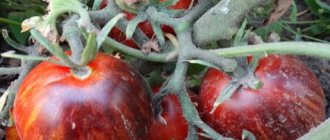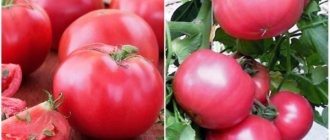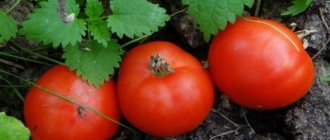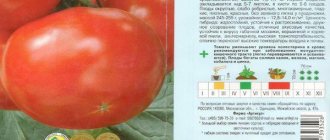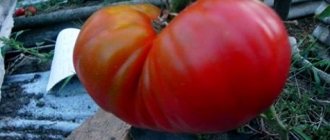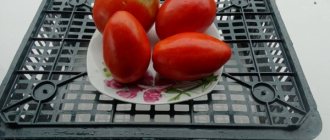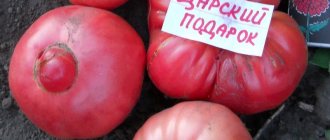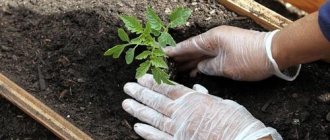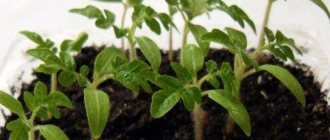Growing tomatoes and reaping huge harvests is much easier if you approach the task with the right variety. Agricultural experts recommend planting Snow Fairytale to everyone who prefers comfortable care.
| Height | Landing location | Ripening time | Fruit color | Fruit size | Origin | Fruit shape |
| short | Greenhouse, Open ground | Mid-season | Reds | Average | Hybrid | Round |
History of variety development
This tomato was created by the famous Novosibirsk breeder V.N. Dederko . This specialist has developed dozens of tomato varieties with improved characteristics that can easily satisfy the demand of vegetable growers from all Russian regions.
Tomato seeds Snow Tale
When breeding the Snow Tale tomato, the breeder tried to create such qualities in it that the tomato could be grown in garden beds in the Western Siberian region. This region is the northernmost in our country for growing vegetable crops in general and tomatoes in particular.
You might like Tomato Royal Gift
The variety was bred at the beginning of this century, passed variety testing and was included in the Russian State Register of Agricultural Achievements in 2006. After variety testing, the Snow Fairy tomato was officially introduced for cultivation in Western Siberia.
The originator of this variety is , which primarily sells “Snowy Fairy Tale” tomato seeds.
Related article:
Why do tomatoes have white streaks inside?
Description of tomato
This standard tomato belongs to the super-determinate type, because its bushes reach a height of 0.45-0.5 m. The central shoot of these tomatoes is tree-like, and the roots are compact.
Tomato Snow Tale is superdeterminate
It is interesting that there are discrepancies regarding the speed of fruit ripening in different sources; some claim that the Snow Fairy Tale tomato is ultra-early ripening, while others classify this variety as mid-ripening. And the originator of the variety talks about the average period of ripening of the rafts of the Snow Fairy Tale tomato, and gives the following figures: from the moment of germination of the seed material to the harvesting of ripe tomatoes, 3.5 months pass.
We also recommend looking at Tomato Titan
Short shoots are well leafed, and the foliage is located close to each other. As a result, the yield of this variety is approximately the same as that of other determinate tomato varieties.
The foliage of the Snowy Tale tomato is typically tomato, narrow and long with sharp tips, velvety, dark emerald.
This standard variety practically does not form stepsons, so there is no need to remove them. Forming bushes and tying up shoots is also not tedious. As a result, caring for the Snow Tale tomato becomes much easier.
What are standard tomatoes
Snow fairy tale tomatoes in a greenhouse
The flowers are collected in racemose inflorescences, and sometimes there are too many of them - up to 10 pieces, so to obtain large enough fruits it is better to remove some of the flowers.
Related article:
Tomato Heavyweight of Siberia - description and characteristics of a large-fruited variety
The inflorescences of this tomato are simple, the first is usually formed under the 7th leaf, and the rest - through one leaf.
Since the fruits of this variety ripen unevenly, during their ripening the bushes of this tomato variety look very decorative: tomatoes of different colors hang on them at the same time - white, orange and red, which look very impressive against the background of velvety leaves.
Ripe tomatoes are small, round, similar to New Year's balls. At the stage of technical maturity, the fruits are painted in a beautiful milky color, and as they ripen they become bright red.
The weight of ripe fruits is usually about 70 g, but if you reduce the number of flowers in the inflorescences and provide the bushes with good care, you can collect large fruits weighing up to 200 g from the bushes.
Related article:
Low-growing varieties of tomatoes for the greenhouse
Snow fairy tomato
The skin of the fruit is dense and smooth; inside there is juicy pulp with 4-5 seed chambers and a small amount of seed material. The taste of ripe tomatoes is moderately sweet with a slight sourness.
It should be noted that the harvested crop does not tolerate transportation well even over a short distance - the fruits can burst and leak. And collected tomatoes are also not subject to long-term storage.
How to grow seedlings
Preparing seedlings is an important stage that should be carried out according to all the rules. The quality and quantity of the future harvest largely depends on the seedlings.
Seed preparation
Experienced gardeners advise disinfecting the material before planting.
This is done using hydrogen peroxide or a solution of potassium permanganate. These simple steps will help you avoid diseases, get rid of larvae, and disinfect the material. You should also think about hardening the seeds, especially if planting is planned in a region with difficult climatic conditions. To do this, place the seeds in the freezer overnight, then leave them at room temperature for the day.
Next, you need to repeat these steps several times. With the help of this mechanism, the seed material develops immunity to frost and sudden climate changes.
The last stage of seed preparation is soaking the material. This is necessary to prevent disease. The seeds are wrapped in gauze and placed in a plate with a small amount of water. They need to be stored in this form for about a month before planting in the ground, maintaining optimal air temperature and avoiding hypothermia.
However, some gardeners are skeptical about soaking seeds. There is an opinion that a larger amount of harvest is obtained only from dry seed material.
Container and soil
You can prepare the soil yourself. To do this you will need dry and clean soil, peat, ash and sawdust. For 4 parts of the earth there is one part of the other elements. All ingredients must be mixed, sand or humus added. Most importantly, do not forget to disinfect the composition you prepared yourself. The same solution of potassium permanganate will help with this.
If you don’t have the time or desire to prepare the soil yourself, ready-made mixtures will come to the rescue. For example, soil “Krepysh”. Such products already contain the necessary supply of vitamins and minerals. The soil is sold at any gardening store.
As for containers, any clean containers are suitable for seedlings. These can be flower pots, wooden boxes, plastic jars. If you don’t have any free containers on hand, buy special containers for seedlings at a gardening store.
Sowing
It is recommended to plant Snow Queen seeds at a distance of 10-15 cm from each other. Make small holes in the soil, place the seed there and cover with soil. Afterwards you need to water them with warm water. Already in the early stages, growth stimulants can be used. So the first shoots will appear much earlier.
Growing and care
Store containers with seedlings in a bright and dry place. If the room is in the shade, provide the plant with additional lighting using lamps. Carefully monitor watering and do not allow excess moisture in the containers.
Reference. Gardeners recommend using pipettes for watering. With this simple tool, water will get under the base of the stem and not onto the leaves.
After 3-4 weeks from the moment of planting, it is recommended to apply the first fertilizing. These can be both professional preparations and folk recipes. For example, an ash-based solution would be an excellent addition.
If you observe that the leaves have become yellow with red veins, it means that the plant does not have enough nitrogen. Use nitrogen-containing fertilizers. An excellent option would be to spray the leaves with mullein solution.
Productivity
This tomato variety has good yield - up to 30 tomatoes of varying degrees of maturity hang on the bush at the same time. In total, up to 9-12 kg of ripe fruits are collected from one square area.
Related article:
7 varieties of cherry tomatoes for open ground or greenhouse
Tomato Snow Tale: cultivation, reviews, photos
When growing this tomato variety on an industrial scale, up to 280 centners of ripe products can be collected from each hectare.
Gardeners' opinions regarding the variety
You should definitely read reviews before planting any tomatoes on your site. It is in them that people reflect their true emotions, opinions and even valuable advice.
- Elena Zhukova. Tomatoes were grown in open ground. One accidentally ended up in a greenhouse; the bush was better. But the harvest is the same. We concluded that it should be grown only in open ground. Next year they will definitely grow more. The harvest is truly fabulous.
- Summer in the village. The appearance of the tomato variety is difficult to confuse with others. The fruits were even and identical, 60-70 grams each. All liked it. They will definitely grow it next year.
- Vladimir. They put him in for testing. I didn’t like the taste of the tomatoes, or they were overfed, or they didn’t have time to ripen.
- Violet Trait. I found the ideal tomatoes for my region. I liked the undemanding nature of the variety when it comes to bush formation. And the fact that there were a lot of fruits. The most important thing is that they are all the same size, perfect for canning and fresh consumption.
Growing tomatoes is a complex process if all agrotechnical requirements are followed. But “Snow Fairy Tale” tomatoes do not require special procedures to care for and increase the yield.
Diseases and pests
This tomato variety is characterized by average resistance to the main diseases characteristic of tomatoes. Therefore, it is recommended to carry out preventive measures by treating the soil and tomato bushes with appropriate preparations to prevent the appearance of pathogenic microorganisms.
Black leg in tomato seedlings: how to treat, what to do
Tomato Snow Tale: cultivation, reviews, photos
Advantages
The main advantages of the Snowy Tale tomato variety over other tomatoes are as follows:
- There is excellent growth and ripening of fruits in bushes of this variety both in garden beds and in greenhouse conditions;
- the variety develops well in rainy, cold weather;
- the originators of the variety guarantee good fruiting in any climatic conditions;
- the yield of the variety is quite high for a determinate variety;
- the bushes of this tomato do not require special care, so they are suitable for growing for those who do not have much time for the garden;
- the fruits have a beautiful shape, equal size and good taste;
- seed material collected from fruits grown in the garden has almost 100% germination.
Related article:
Large-fruited tomato variety Eagle Heart
Among the disadvantages, it should be noted that the harvested crop practically does not tolerate transportation and is stored for only a couple of days in any conditions.
Sowing seeds for seedlings with your own hands
Snow fairy tale, like many other varieties, is grown in seedlings. Of course, you can buy seedlings already ready for planting in the ground. But it’s better to grow it yourself from seeds. Good results are shown by seeds collected personally from last year's harvest.
Optimal timing
You need to plant seedlings in the ground in the middle - in the second half of May. At this time, a stable positive temperature is established. This means you can sow seeds throughout March. This is the optimal period for the seedlings to become sufficiently strong before planting in a permanent location.
Soil mixture
You can purchase substrate for tomatoes in specialized stores. Experienced gardeners believe that it is better to prepare the soil yourself to be sure of its quality.
Tomatoes love peaty, loose soil.
To prepare it you need to mix:
- peat - 2 parts;
- garden soil (from that part of the garden where tomatoes and other nightshades did not grow) - 1 part;
- sand - 1 part;
- humus or compost - 0.5 parts;
- fertilizers: urea (10 g), superphosphate (30–40 g), potassium salt (10–15 g);
- one of the raising agents: sphagnum, coconut chips, perlite, vermiculite or sawdust.
Growing container
Seedlings of Snowy Tale, like other tomatoes, are grown in 2 stages: before picking and after. Therefore, she needs containers of different sizes: shallow for the first stage, separate deeper containers for the second. The first dish should be shallow, because... It's comfortable for little sprouts.
If you immediately plant the seeds in a deep container and do not dive, the roots will become tangled and can be damaged during replanting.
The first container can be:
- wooden or plastic boxes;
- trays and cassettes for seedlings;
- plastic cups (100 g);
- peat tablets.
Important! Whatever container is chosen (except for peat tablets), before sowing the seeds it must be disinfected with a solution of potassium permanganate. This is especially important if it has already been used for growing seedlings
Tomatoes grow and develop better in individual containers (cups, tablets, trays with a partition). But with the appearance of 2 leaves, the seedlings still need to be planted in a larger container.
Seed preparation
Tomato seeds also need to be prepared for sowing, regardless of whether they are purchased or collected by hand. Preparation includes several actions: some are mandatory, while others depend on the wishes of the gardener.
Mandatory preparation:
- rejection: immerse the seeds in salt water for 10 minutes (1 teaspoon of salt per 1 cup of water), the floated specimens are rejected, because they are empty, but the full ones are washed and dried;
- disinfection: to destroy possible bacteria on the surface of the seeds, they are soaked for 20 minutes in a 1% solution of potassium permanganate (pink) or for 7-8 minutes in a warm 2% solution of hydrogen peroxide.
To speed up seed germination and increase their fertility, many gardeners take additional steps:
- soak them for 24 hours in one of the growth stimulants (Epin, Virtan-Micro, potassium or sodium humate) or use folk remedies for this, for example, aloe juice or potato juice;
- Germinate the seeds on a damp gauze cloth at room temperature.
Sowing seeds
The container for sowing is filled with soil mixture, having previously covered the bottom with a layer of drainage. First, the soil is watered with warm water, and when it is absorbed, planting begins.
Planting scheme in a common box:
- depth - 1 cm;
- the distance between the grooves is 4 cm;
- the step between seeds is 2 cm.
Place 2-3 specimens in separate cups so that you can then choose the strongest one. The sown seeds are sprinkled with a thin layer of soil and, if necessary, moistened with a spray bottle. Then the box is covered with film or glass and placed in a warm place until shoots appear.
Seedling care
For seedlings to grow strong and normally developed, they need a warm and well-lit place. This could be the window sill of a south window.
Conditions for normal development:
- temperature: +22…+25°С under the film before germination and +17…+18°С - after removing the film;
- lighting for 12 hours, you can use a phytolamp to extend daylight hours;
- moistening the soil as it dries by spraying with water at room temperature;
- There is no need for fertilizing if the soil has been fertilized before sowing;
- diving is necessary when 1-2 leaves appear in separate cups or pots (0.5 l).
Hardening of seedlings
Hardening off is a necessary step that will help tomato seedlings avoid stress when transplanted into open ground and quickly take root.
Seedlings are hardened off:
- 2 weeks before landing at a permanent place;
- taking it outside or onto an open balcony at an air temperature of +8...+15°C;
- gradually extending your stay in the fresh air from 30 minutes to 10 hours.
Landing
Although this tomato variety is recommended only for cultivation in Western Siberia, many gardeners grow it in the middle zone and in other regions with similar climatic conditions and a short, cool summer period.
Tomato seedlings Snow Tale
Typically, this tomato variety is grown in seedlings. To do this, seed material is planted in containers with purchased nutrient substrate throughout March.
After the plants have their first true leaves, they should be pruned (if the seedlings are planted too densely). About a couple of weeks after this procedure, you need to feed the seedlings with urea or other fertilizer containing a sufficient amount of nitrogen.
Another good variety is Tomato Verochka F1
Usually, if all care rules are followed, seedlings grow strong and healthy. Seedlings are usually transplanted into garden beds or greenhouse conditions at the age of 2 months, when the plants have at least 7 permanent leaves and at least one inflorescence.
Related article:
Two buckets from each bush or how to achieve high tomato yields
During transplantation, the air temperature should constantly remain around +14+15 degrees Celsius, and the soil warms up to +15 degrees Celsius.
Planting seedlings in the ground
Before transplanting, it is recommended to harden the tomato seedlings by taking them out into the fresh air for a short time at first, but gradually increasing the time in the air for these plants.
Features of cultivation and storage
On the beds there are no more than 4-6 bushes per 1 m2. Fertilizers are first applied to the soil, the following components are added per 1 m2:
- compost 7 kg,
- superphosphate 20 g,
- potassium sulfate 5 g,
- wood ash 1 cup.
Pay attention to predecessors. The most successful varieties for tomatoes are carrots, greens, zucchini, and salads.
Features of cultivation:
- Water moderately 2-3 times a week, water consumption per bush is 7-8 liters.
- They are fed with organic matter, saltpeter, and phosphorus-potassium composition.
- Mulch with a layer of leaves, straw, hay.
Ripe tomatoes can be stored for no more than 2-3 weeks.
Further care
After planting the tomatoes in a permanent place, they are covered with non-woven material to protect them from low air temperatures.
Formation of bushes and garters
The main thing is that when caring for this tomato, you do not need to form bushes and remove stepsons. And these bushes need a garter only in case of overload with the harvest - when too many fruits ripen on the plants at the same time, the shoots can break under their weight.
Related article:
Tomato variety Fleshy sugary
Formation of tomato bushes in a greenhouse
Disease Prevention
To prevent the bushes of this tomato from being affected by various diseases, it is recommended to carry out preventive plant treatments during the summer season.
To do this, prepare solutions of drugs such as Fitosporin, Glyocladin, or use other similar fungicides. In total, at least two such treatments should be carried out during the season with an interval of 20-30 days.
Also, Snow Fairy Tale tomato bushes require regular watering, as well as fertilizing several times a season. Moreover, the need for nutrients of Snow Fairy tomato bushes increases during the period of flowering and fruit ripening.
How to grow tomatoes
The process of growing the Snow Tale tomato is long but pleasant. The variety does not require special care, which makes it even more popular among gardeners.
Landing
Be sure to disinfect the soil one week before planting. Collect all the remains of previous plants, pegs, ropes and burn them. A solution of copper sulfate and hot water is perfect for disinfection. Spray the soil thoroughly with it, not missing a single area.
It is best to plant tomatoes in the morning on a cloudy day. Beds of potatoes, cabbage, and cucumbers will be excellent predecessors. The planting should not be dense, otherwise the bushes will interfere with each other. The optimal distance between them is about 40 cm. The final stage of planting consists of abundant watering with warm water.
Care
Regularly remove weeds from the beds with Snow Fairy Tale, otherwise they will take all the nutrients from the plant.
Watering is carried out according to general rules. Try not to let water get on the leaves, otherwise the variety will develop late blight in the future. The plant does not form stepsons and does not need tying.
To prevent diseases and infections, gardeners advise feeding tomatoes in a timely manner. Nitrogen-containing substances are excellent for this, as they replenish the lack of nitrogen and protect the bushes from parasites.
In addition, the required level of nitrogen improves the plant’s metabolism and has a beneficial effect on the taste of the future harvest. Ammonium nitrate is recognized as the market leader.
Features of cultivation and possible difficulties
At the seedling stage, it is recommended to carry out one pick, that is, transplant the sprouts from the container into a larger container. This is done after two full leaves appear on the stem. At the planting stage, periodically loosen the soil - this way more oxygen gets into the soil, it becomes enriched and light.
Among the difficulties of growing, we note the likelihood of diseases and the occurrence of parasites. Otherwise, growing a Snow Fairy Tale does not require special skills.
Diseases and pests
In the list of the most common diseases, the fungal infection late blight takes first place. Fungal spores penetrate the stem and leaves, causing the latter to turn yellow with brown spots. The fungus takes the lion's share of nutrients from the tomato, causing the vegetable to slowly die.
It is not easy to fight late blight, but sometimes it is possible to save the crop. For treatment, it is recommended to use the above-mentioned solutions based on potassium permanganate or ash.
Tobacco mosaic disease also deserves special attention. It appears as a yellow pattern on the leaves of plants. Tobacco mosaic occurs for various reasons: excessive watering, lack of fertilizers. A solution of whey and warm water helps against the virus.
Important! To prevent the plant from getting sick, take preventive measures in advance. In no case do not forget to disinfect and fertilize the soil on time.
Of the parasites, special attention should be paid to mole crickets, spider mites, and whiteflies. These insects live off the nutrients of plants, as a result of which the latter dies. To combat them, it is better to immediately resort to proven means - an infusion of dandelion or garlic or a solution based on tobacco leaves.
